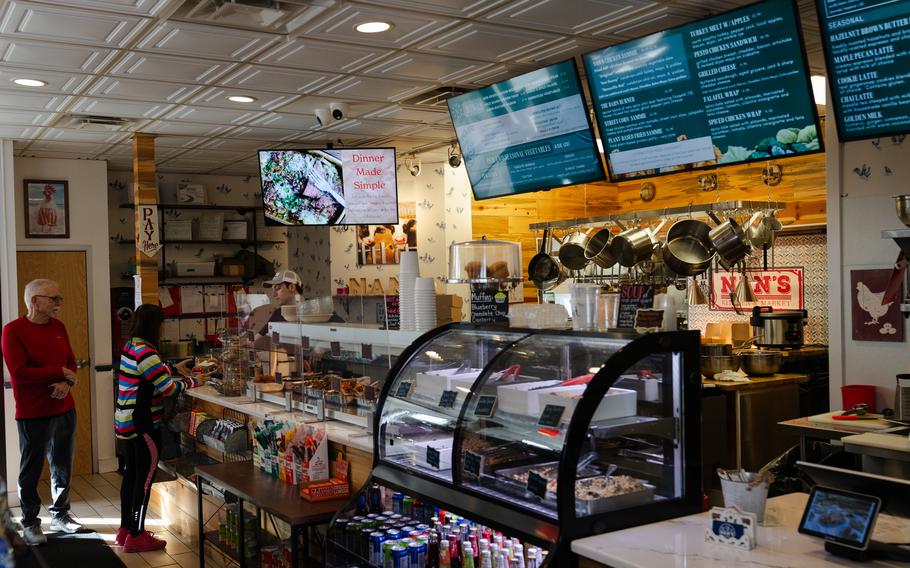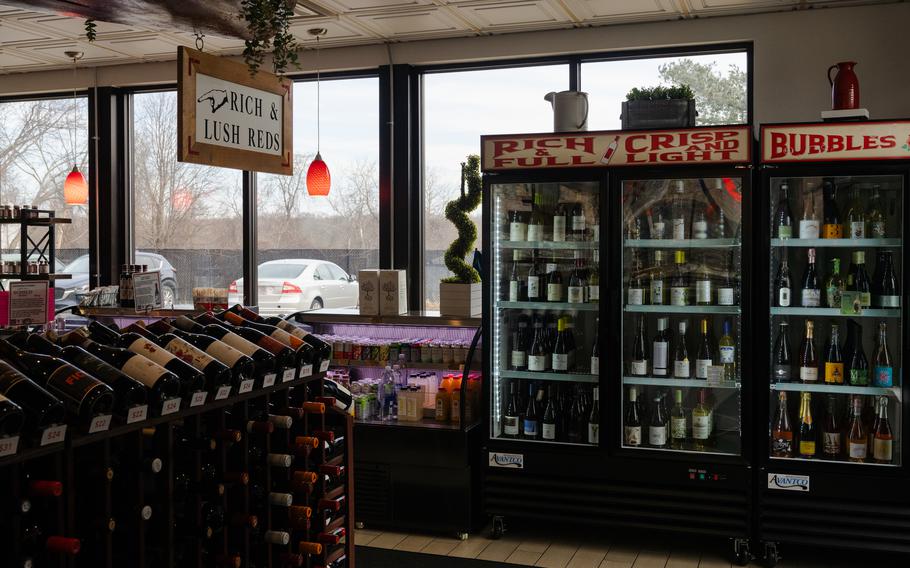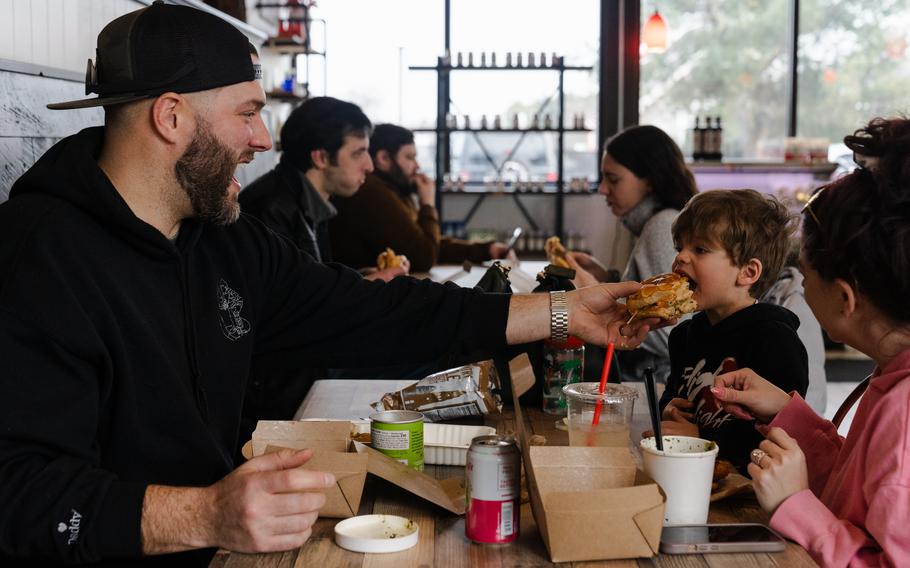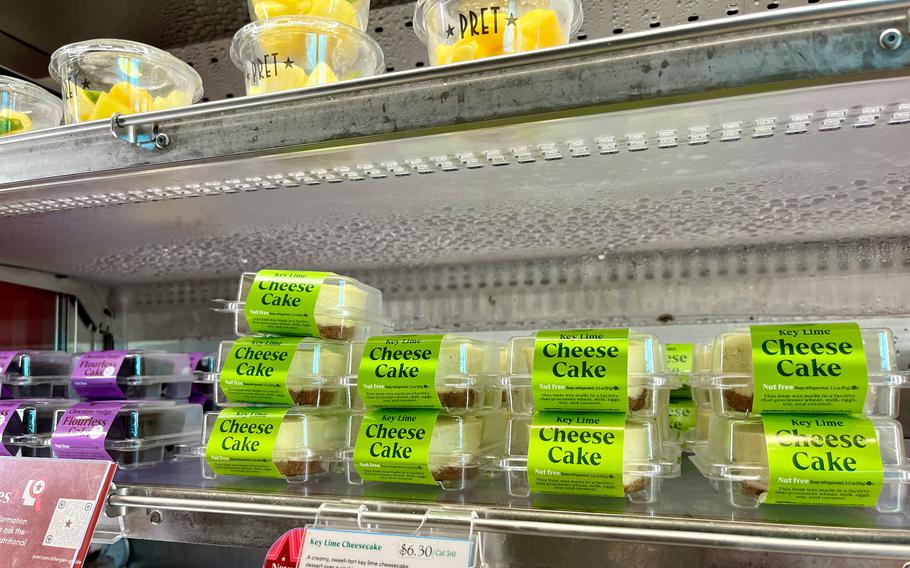
People order at Nan’s Kitchen & Market, described on its website as a place for “fresh and wholesome food, sourced as close to home as possible.” Nan’s has two locations in Massachusetts. (Natalie Compton/The Washington Post)
SOUTHBOROUGH, Mass. — The old Wendy’s is just off Interstate 495, about 30 miles west of Boston. It still has the squat exterior of a ’90s-era fast-food restaurant, with curved eaves above big windows overlooking a wraparound drive-thru. But you won’t find square burgers and Frostys inside.
At Nan’s Kitchen & Market, customers eat Nashville hot chicken sandwiches on pillowy rolls dressed with smoky mayonnaise and shaved cabbage slaw. People waiting for their orders browse aisles of craft beer and locally made soaps. Takeout boxes contain medium-rare flank steak or pesto grilled broccoli from a nearby farm. Commodity coffee is out. Brown butter hazelnut lattes are in.
![Fried chicken sits in baskets at Nan’s. “It’s not really the chicken that makes money,” said Jordan Mackey, Nan’s chef and owner. “You’re making money when [customers] buy biscuits, mashed potatoes and vegetables.”](https://www.stripes.com/incoming/mgaahm-travel-reststops-corrected_ze7662h5ied467jxx7wkhyjafy.jpg/alternates/LANDSCAPE_910/travel-reststops-corrected_ZE7662H5IED467JXX7WKHYJAFY.jpg)
Fried chicken sits in baskets at Nan’s. “It’s not really the chicken that makes money,” said Jordan Mackey, Nan’s chef and owner. “You’re making money when [customers] buy biscuits, mashed potatoes and vegetables.” (Sophie Park/For The Washington Post)
Anyone who has traveled America’s highways has learned to lower their expectations for pit-stop meals. The most common options are gas stations stocked with shelf-stable snacks and hot dogs rolling under a heat lamp, or chain restaurants serving ultra-processed food. To discover Nan’s — described on its website as a place for “fresh and wholesome food, sourced as close to home as possible” — on a long slog from Washington, D.C., to Portland, Maine, felt like a shock to the status quo.
My fiancé and I perused the market full of “shoppy shop” items, the type of impulse buys that lure urbane consumers with jazzy packaging and marketing copy describing independent, gourmet purveyors. We combed through the selection of natural wines and CBD dog treats, chocolate-covered pretzels and nonalcoholic aperitifs. Per the glowing reviews online, we ordered the Nan’s original fried chicken sammie ($10.95) plus a grain bowl with lemon-brined salmon ($15.95). It was all fantastic.

A large wine selection is on display at Nan’s. Nan’s also sells CBD dog treats, chocolate-covered pretzels and nonalcoholic aperitifs, among other items. (Sophie Park/For The Washington Post)
It all felt designed for travelers like me, someone who will subsist on Cheez-Its and pistachios in a pinch but would rather seek out a meal from a local place with a story behind it. As we drove away with a few bottles of Sicilian red in the trunk and zero food coma, the experience made me wonder: Was Nan’s a unicorn? Or is road trip food getting better?
Pandemic pivot strikes a chord
To understand the state of road trip food, look at how Nan’s wound up in a Wendy’s.
“I’ve been in the fine dining industry for a very long time,” said Jordan Mackey, Nan’s chef and owner. “I spent most of my career in four- and five-diamond hotels, Michelin restaurants, that kind of thing.”
He and his wife, Reanna, bounced around a lot for hospitality jobs — his in kitchens, hers in the front of the house. When they came back to New England after years working around the country, they noticed a hole in the regional market for a great fried chicken spot. There are no Publix supermarkets — renowned for their fried chicken — in the area, and the sides at places like KFC left him wanting.
Between 2015 and 2017, the couple wrote a business plan for an “upscaled” restaurant that served thoughtfully sourced vegetable side dishes, “almost like a high-end Cracker Barrel,” Mackey said, “where we could take really good scratch-made food and put real nectarines in our lemonade — that kind of thing.” There’d also be a country store element where they could sell local eggs and dairy as well as artisanal goods.
The plan sat on the shelf as a distant dream until the coronavirus pandemic hit, decimating the middle class of dine-in restaurants in favor of extreme luxury and more fast-casual choices.
About 10 months after opening a 275-seat Mediterranean restaurant in Sudbury, Mass., they had to shut down for a lockdown. By May 2020, seeing no relief in sight, they decided to bet their remaining savings on the fried chicken concept. They found a farmhouse turned bed-and-breakfast in Stow, Mass. After negotiating a lease and finishing some construction, they got the first Nan’s open that November.

Tyler Connelly, 37, left, shares a bite of his fried chicken sammie with 2-year-old Kade Connelly. (Sophie Park/For The Washington Post)
“It took off like a rocket ship within 90 days,” Mackey said. “We were exceeding our pre-COVID revenues at our full-service restaurant.”
Following the success of their first store, which catered to local customers, the Mackeys searched for a second location. They found a shuttered Wendy’s a short detour from the highway, just beyond a gas station and a Red Roof Inn. It was almost like bringing the Wendy’s back to its roots; in 1979, it became the first nationwide fast-food chain to introduce a salad bar. The company phased out the offering by the late ’90s.
“We were like, ‘How cool would it be to convert a Wendy’s into a healthy restaurant?’” Mackey said.
The fast-food chain builds “really good kitchens,” Mackey found, so no renovations were needed there. The outside got a paint job reminiscent of the Chip and Joanna Gaines treatment: cream brick, black and tan accents, a few rusty shovels hanging on a wall near the entrance. It opened in August 2022.
The sequel was a hit, too. Now they hope to open two more locations this year.
“It shows we’ve got something here that’s repeatable,” Mackey said.
Truck stop sushi and samosas
Americans’ spending habits suggest they’re hungry for more than mass-produced hamburgers. Regional brands like Buc-ee’s and Wawa have used their kitchens to convert drivers into regulars with Texas barbecue and hoagies.
Some people may say they don’t want to eat sushi from a gas station. But according to Darren Schulte, vice president of membership for the National Association of Truck Stop Owners, sushi is among the bestselling items at the truck stops, travel centers and fuel retailers that make up the trade group.
Before the pandemic, Schulte would spend 50 weeks of the year traveling to visit member operations located off exit interchanges across the country. They range from national and regional chains to mom-and-pop outfits that cater to both truckers and civilian drivers, serving a much broader selection of cuisine than you’d expect (unless you live in the South and already know the drill).
“We are kind of like these hidden gems,” Schulte said. “People [don’t] really know what trucks and travel centers offered.”
He rattles off examples like the memorable butter chicken at Refresh Travel Plaza in Madera, Calif.; the catfish and shrimp po’ boys at Port Fuel Center in Savannah, Ga. (they also have a salad bar); Slovacek’s West in the town of West, Texas, which has Czech kolaches, sausages and other Eastern European baked goods.
“I was at a truck stop not too long ago that had some of the best Thai spring rolls,” Schulte said. “They were phenomenal tasting, made fresh right there every morning … so I think what you’re seeing as the United States itself is changing, you’re seeing that same change in [travel] food offerings.”
A chain trying to do better
The Biden Welcome Center off Interstate 95 in northern Delaware has the usual suspects: Dunkin’, Burger King, Cinnabon, Panda Express and Hudson News, a market with packaged foods you usually find at an airport.
But when I stopped there over the summer, I also found a few surprises: There was a cake vending machine selling refrigerated slices from Carlos Bakery, of “Cake Boss” fame; a freezer stocked with “premium” Mexican ice cream bars; and, most exciting to me, a Pret A Manger.
If you’re not familiar with the brand, Pret is a U.K.-based chain that has expanded across the pond since its founding in the ’80s. It’s not a little guy like Nan’s, but the chain feels light-years more inspired and wholesome compared with other rest stop giants. The company serves a range of premade sandwiches, salads, soup and juices. It touts its organic coffee, donates unsold food and has committed to following Global Animal Partnership standards for 100% of its chicken products by 2026.
“We like to say that we sell fresh food, fast, but we’re not ‘fast food,’” Pret’s North America president, Jorrie Bruffett, said in an email.
At the Biden Welcome Center, the Pret was selling key lime cheese cake ($6.30); tomato and feta soup ($7.69 for the small size, $8.79 for the large); ginger shots ($4.79); and a “Little Cup of Goodness,” a.k.a. Greek yogurt with granola, julienne apples, brown sugar and cinnamon ($7.69). I got a turmeric falafel wrap with hummus, pickles, pickled cabbage and carrots with romaine lettuce, plus a banana, all for $17.27.

Pret A Manger desserts at a Delaware rest stop. Pret A Manger is a U.K.-based chain that has expanded across the pond since its founding in the ’80s. It sells a range of premade sandwiches, salads, soup and juices and touts its organic coffee. “We like to say that we sell fresh food, fast, but we’re not ‘fast food,’” Pret’s North America president, Jorrie Bruffett, said in an email. (Natalie Compton/The Washington Post)
Pret has a few other traveler-friendly locations, including on the New Jersey Turnpike, in the Los Angeles International Airport’s Tom Bradley International Terminal and in D.C.’s Union Station. Bruffett said the company is “always successful” in “travel locations” like rest stops, train stations and airports — but he did not share specifics about plans to add similar locations in the near future. Why aren’t there more good options?
Pret is not the only chain promising healthier options for traveling Americans. Mackey points to the Farmer’s Fridge vending machines that dispense salads and grain bowls at more than 20 airports. Alltown Fresh, described on its website as “a farm stand meets a restaurant meets roadside convenience,” has more than 16 locations selling a range of sandwiches, salads and smoothies in New England, mostly at gas stations.
There are other independent businesses trying, too — like Rachel Krupa, a publicist who in 2018 opened the Goods Mart in Silver Lake, L.A., with a mission of re-creating a classic convenience store with better-for-you products.
“Everything in the store is non-GMO,” she said. “There’s no artificial flavors. There’s no dyes. And then on top of that, they’re all young and emerging brands.”
That means tins of smoked Atlantic salmon from Fishwife and prebiotic-filled Olipop instead of Pepsi. In the past six years, Krupa has opened three stores in New York City and closed the original L.A. branch. Now she is looking to consult with traditional convenience stores to help them stock their shelves for the next generation of shoppers that are willing to pay a little more for high-quality ingredients.
The issue isn’t just figuring out what customers want, but also how to get it to them. The biggest challenge for new specialty brands, Krupa said, is that they’re not available from the classic distributors that serve convenience stores across the United States.
“On the backside, it’s very complicated,” Krupa said.
For businesses like Pret, Bruffett said the main challenge is sourcing fresh ingredients.
“Our current shops at rest stops are all within our existing East Coast distribution footprint making food deliveries as efficient as possible,” he said. “As we expand our footprint, we establish new distribution points that enable us to get the same high-quality ingredients into every Pret shop.”
And for Nan’s, finding qualified labor is the biggest obstacle.
“It’s a scratch concept, and we need chefs to run this,” Mackey said. “We focus on applying really good skill and labor to inexpensive vegetables.”
With the right talent, Mackey says he can transform cheap ingredients like potatoes, cucumbers and broccoli into side dishes that help the restaurant’s bottom line. That’s a critical step because “it’s not really the chicken that makes money,” he said. “You’re making money when [customers] buy biscuits, mashed potatoes and vegetables.”
If the new wave of better-for-you businesses can work out the math, there is a market of travelers out there ready to support them.
“There’s definitely demand for fresh, high-quality food options at rest stops, just as we see in our non-travel locations,” Bruffett said.
Mackey said about the same. Krupa said the best way to encourage the industry in this direction is to support the brands making the effort. On the corporate level, decision-makers will only call for change if they see a shift in how customers spend their money.
“Consumers are the ones that are driving the trends,” Krupa said. “Each individual person’s dollar is power.”